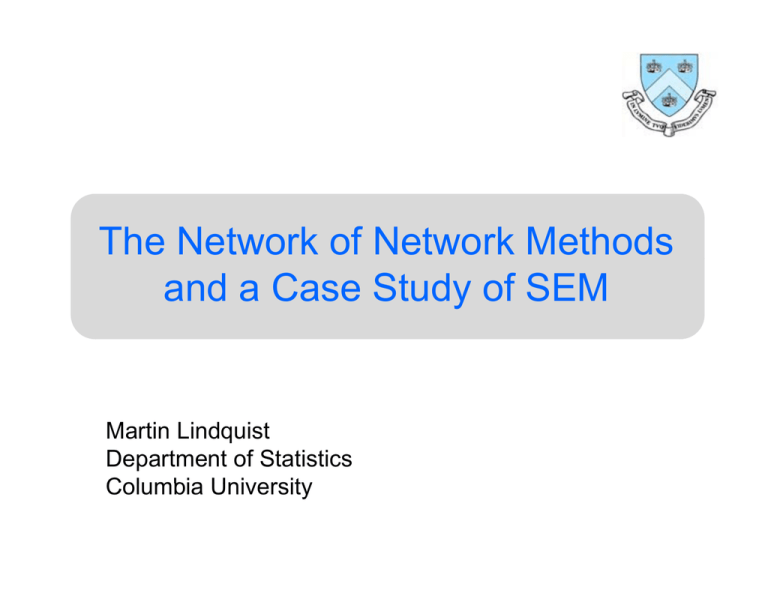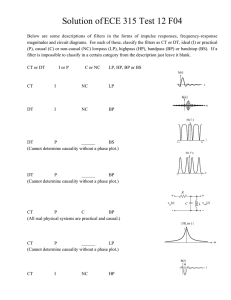The Network of Network Methods and a Case Study of SEM
advertisement

The Network of Network Methods and a Case Study of SEM Martin Lindquist Department of Statistics Columbia University Brain Networks • It has become common practice to talk about brain networks, i.e. sets of interconnected brain regions with information transfer among regions. • To construct a network: – Define a set of nodes (e.g., ROIs) – Estimate the set of connections, or edges, between the nodes. A B C A 0 0 0 B 1 0 1 C 0 1 0 B A C Network of Network Methods • A number of methods have been suggested in the neuroimaging literature to quantify the relationship between nodes/regions. • Their appropriateness pp p depends p upon: p – what type of conclusions one is interested in making; – what type of assumptions one is willing to make; – and the level of the analysis y and modality. y Network Methods Correlation Coherence Granger Causality Mutual information Structural Equation Models Partial correlation Dynamic Causal Models Inverse Covariance Methods Bayes Net Methods Independent Components Analysis Graph Theory Principal Components Analysis Partial Least Squares Characteristics • When choosing which method to use we must carefully weigh their specific characteristics: – – – – – – – – – Linear or non non-linear linear Deterministic or stochastic Static or dynamic y Directional (Yes/No) Acyclic (Yes/No) D t or model-driven Data d ldi Number of regions allowed Allow for search across regions (Yes/No) Include biophysical information (Yes/No) Use these characteristics to group the methods into a network Network of Network Methods DCM ICA GC BN GT PLS SEM PCA IC PC Coh MI Cor Brain Connectivity • Functional Connectivity – Undirected association between two or more fMRI time series. – Makes statements about the structure of relationships among brain regions regions. • Effective Connectivity – Directed influence of one brain region on the physiological activity recorded in other brain regions. – Makes statements about causal effects among tasks and regions. Classification Functional Connectivity Association Correlation Partial correlation Mutual information Coherence Inverse Covariance PCA, PLS and ICA Graph Theory Is this too rigid? Effective Connectivity Causation Granger Causality SEM DCM BN Revised Classification Functional Connectivity Effective Connectivity Association Causation Correlation Granger Causality Partial Correlation BN/DCM/SEM In reality the situation is much more fluid. For example, in some situations correlations may indeed imply causation. Connectivity and Causality • Effective connectivity is popular because it is thought to provide more powerful conclusions. • However, it also rests on stronger assumptions. – The validity of the conclusions depend strongly on certain ass mptions being correct assumptions correct. – They are often external to the applied method. – Theyy are often poorly p y specified p and difficult to check. • How can we better understand these assumptions? Potential Outcomes • Growing statistics literature on causal inference – Based on ideas from experimental design. – Requires causal relationships to sustain counterfactual conditional diti l statements. t t t – Counterfactual ideas can be expressed using potential outcomes notation. – Gives conditions under which commonly used estimates actually estimate causal effects. • Most brain connectivity methods can be expressed in the potential outcomes notation and assumptions for making causal interpretations can be derived. Example • Consider an experiment with 6 subjects, half in a treatment group and half in a control group. • Suppose we measure an outcome for each subject. • We want to determine what effect the treatment has on the outcome. Z Y Treatment Outcome Example • Let Zi be the treatment given to subject i. 1 if subject i was treated Zi 0 if subject i was untreated • Let Yi denote the outcome. • There are two potential outcomes: – Yi(1) is the outcome if subject i is treated – Yi(0) is the outcome if subject i is untreated • Subject-level causal effect: Yi(1) - Yi(0) – Only one of the potential outcomes can be observed observed. • Average g treatment effect: E (Y (1) Y (0)) • Could estimate from the observed data using: E (Y | Z 1) E (Y | Z 0) Subject Z Y(0) Y(1) Yobs Y(1) -Y(0) 1 0 0.7 - 0.7 - 2 0 0.5 - 0.5 - 3 0 0.3 - 0.3 - 4 1 - 21 2.1 21 2.1 - 5 1 - 1.6 1.6 - 6 1 - 2.0 2.0 - Example • In general, need not be equal to . – A non-zero value of implies Z and Y are associated, but not that Z causes Y. • To equate the two terms we need assumptions. – If Y(0) and Y(1) are independent of Z, then = and association is causation. – This Thi is i true t if subjects bj t are “exchangeable” “ h bl ” with ith respect to their treatment. – This will hold if the treatment is randomly assigned. Framework • A framework for identifying causal effects: – Construct a causal model using potential outcomes in order to spell out the causal effects of interest. – Construct a structural model from which we can estimate equivalent effects from the observable data. – Find conditions under which the effects from the causal and structural models are equivalent equivalent. Connectivity and Causality • Suppose subjects are randomized to perform either a stress (Z=1) or control (Z=0) task, X is the brain response in a key stress-related area of the brain, and d Y iis ttask k performance. f • Consider C id th the ffollowing ll i th three-variable i bl path th di diagram: Response X Z Treatment E (Y (1, x 1) Y (1, x)) Y Outcome The effect in the treated group if the brain response was changed from x to x+1. Example • A structural equation model (SEM) is often used to make causal inferences on the parameters. – The validity of the inferences, which equate association and d causation, ti restt upon assumptions ti nott partt off the th SEM. SEM • To estimate the SEM implicitly computes, computes , the difference in response between those treated subjects j with brain response p x and those with x+1. • For = to hold, subjects must be “exchangeable” with respect to their treatment and brain response. Example • Suppose there exist two equally prevalent types of subjects in the study: resiliant and non-resiliant. • Further, suppose that X is binary (0/1) and if resiliant 0.75 P ( X 1) 0.25 if non - resiliant • In addition, resiliant subjects perform better on average than non-resiliant non resiliant subjects at every level of Y under either treatment. Partial table of potential outcomes for the treated group Subject Type Z X(1) 1 R 1 1 1 2 2 2 R 1 1 1 2 2 3 R 1 1 1 2 2 4 N 1 1 0 1 1 5 R 1 0 1 2 1 6 N 1 0 0 1 0 7 N 1 0 0 1 0 8 N 1 0 0 1 0 E (Y (1, 1) Y (1, 0)) Y(1,0) Y(1,1) Yobs 1 1.75 0.25 1.5 The problem is that X is a “self-selected treatment”. Resiliant subjects more likely to “select” X=1 and non-resiliant X=0. Comments • Even in a randomized experiment causal interpretations of SEMs rest on strong untestable assumptions external to the data and method. • Similar arguments can be made for other techniques ( (e.g., DCM or G Granger causality). lit ) – The fact that these assumptions are rarely discussed is a shortcoming g of the field. Conclusions • In brain imaging researchers tend to discriminate between functional and effective connectivity. – This distinction is not entirely clear or relevant. • Conclusions will depend on certain key assumptions externall to the h data d and d the h employed l d models. d l – It is important that these assumptions be specified and attempts made to verify them them. • Causal inference provides a mathematical framework for determining these assumptions. The End • Thanks to Michael Sobel (Columbia University) and Tor Wager (University of Colorado at Boulder). • Reference: R f Lindquist and Sobel (2010). Graphical models, potential outcomes and causal inference: Comment on Ramsey Ramsey, Spirtes and Glymour. NeuroImage, in press. • Funding: NIH - 1RC1DA028608 • Thank you for your attention.





